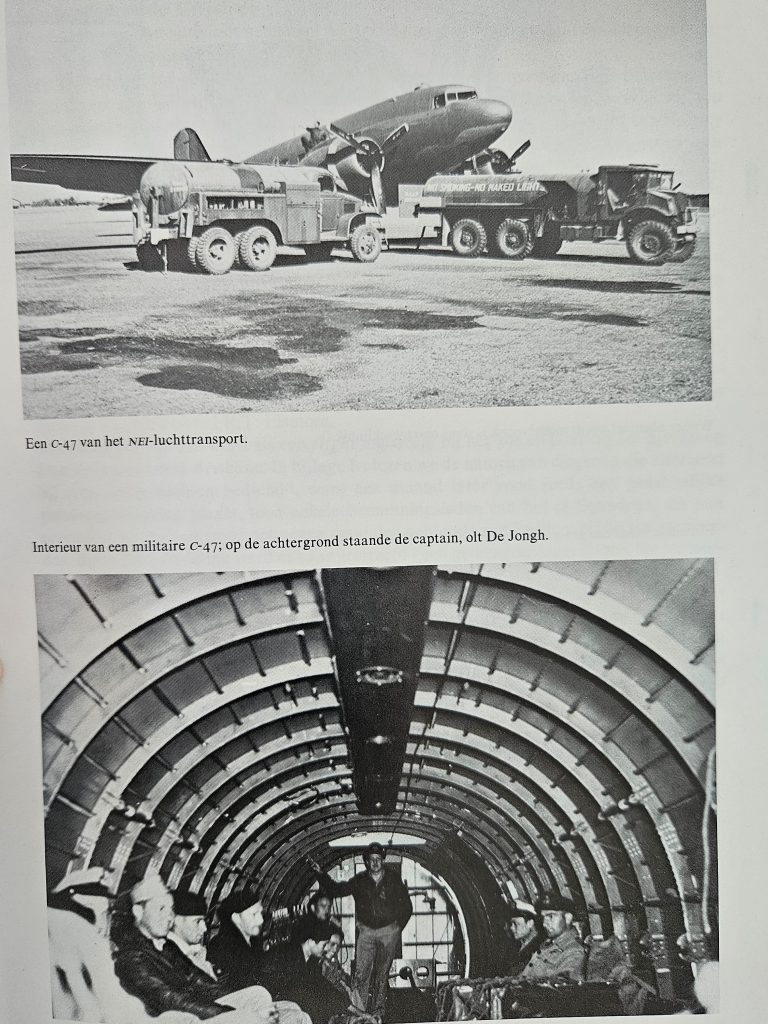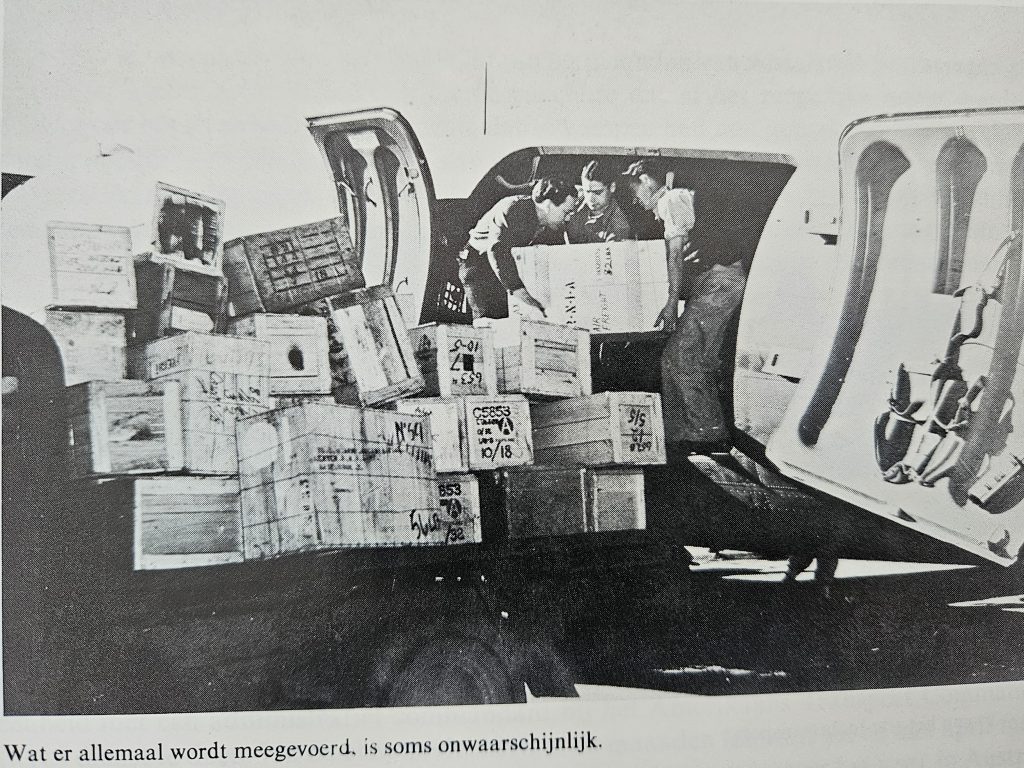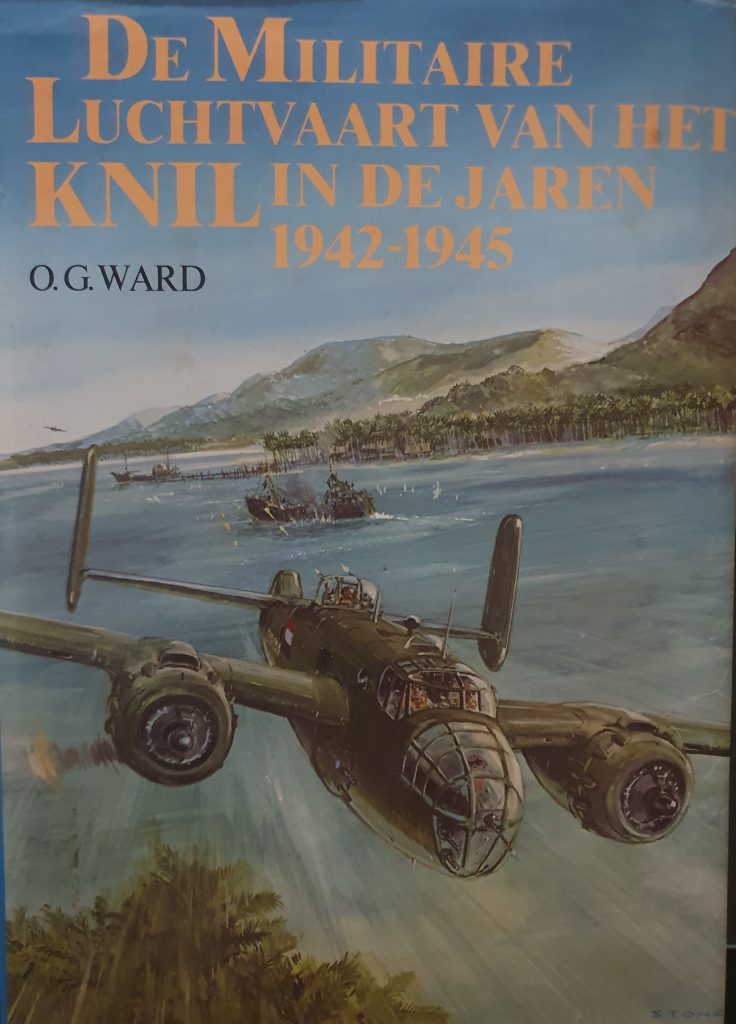Military Air Transport in Australia started soon before the fall of the Netherlands East Indies (NEI). In the few months before this happened evacuations started to happen, mainly of Dutch civilian personnel including families of the Royal Netherlands East Indies Airline (KNILM). These civil aircrafts became the earliest core of military air transport in Australia. They already operated at that time under the command of the Military Airforce Division of the NEI Army (ML-KNIL) . They were also involved in the very last evacuation of people who would later form the Netherlands East Indies Government in Exile, operating from Camp Columbia in Brisbane.

NEI Depot Aircraft Division
In February 1942, a crew from the ML-KNIL was sent to Australia to receive the aircraft from the Americans. This group was known as the Depot Vliegtuigafdeling (NEI Depot Aircraft Division), The largest group of this Division left in four Lockheed Lodestars from Bandung. The detachment consisted of 43 people including Captain Boot, 18 pilots, 7 telegraphists and 14 mechanics. Three arrived at Archerfield Airport on 14 and 15 of February 1942.
En-route from Cloncurry to Archerfield, the third plane with Captain Boot onboard developed severe engine trouble on both engines and made an emergency landing in a meadow at Chinchilla Airport. The captain and four crew traveled by police car to Archerfield. The engines were repaired and a few days later the aircraft continued its flight to Archerfield.
For that purpose, the Depot Aircraft Division of the ML-KNIL had by that time already been formally established at Archerfield, Brisbane.
The handover at Archerfield was thought to only require about a week per crew.
The plan therefor was still to fly the new B-25s from there to Java as soon as possible. The Government hoped they could still be used for the defense of NEI. By this time the Japanese had already invaded NEI (this had started on January 10) and the Japanese were now on their way to Java and the capital Batavia.
It soon became clear that the Dutch were fighting a losing battle and another ML-KNIL detachment departed from Java for Australia. This detachment, led by Major Roos, was tasked with setting up a permanent ML-KNIL organisation in Australia for the operation of the aircraft.
Separately for the supply of the 18 Squadron in MacDonald and later Batchelor, both airfields in the Northern Territory, was in August 1943 in Essendon, Melbourne a 2nd transport division established, the NEI-Transport Section, Melbourne (NEI-TSM).
They both became part of operational groups under RAAF control. All of their stores and equipment were supplied by the United States of America. However NEI-TSM in contrast to NEI-TSB, operated as a totally independent Dutch transport division.
The Brisbane and Melbourne divisions were later combined in one squadron stationed at Archerfield, Brisbane. The aim was to establish 2 transport squadrons, but the main problem that had haunted the Dutch from the beginning was the ongoing chronical shortage of staff.
Initially transport concentrated on foodstuff, goods and personnel. Flights followed strict routes and time schedules. There was also strict control on the shipping lists. Once the Americans started to liberate more and more areas, transpost changed. It now concentrated on food and medical goods for the liberated areas. Bureaucrats were now also flown into these areas to start reestablishing central control and administration.
Flights back also included evacuees from POW camps.

NEI Transport Department Brisbane
In January 1943, the NEI-TSB was the first air transport service formally established after the capitulation.
The Section administered initially eight pilots, four aviation wireless operators, a second pilot-air gunner and eight flight engineers of which three to be cross-trained as second pilots. All were former civil KNILM and KLM personnel evacuated to Archerfield. Following the capitulation of the allied forces in Java they continued to work for the KNILM for about one-and-a-half-month operating charter flights within Australia. By May however they all had ended up jobless because the company ceased operations when their planes were sold to the Americans.
Consequently, some of them were seconded to the ML-KNIL and became the core of the new Transport Section (TSB). The NEI-TSB was equipped with three Lockheed Lodestars and five B-25 Glen Mitchell´s.
They became a flight unit of the USAAF especially attached to the 39th Troop Carrier Squadron (TCS) and the 317th Troop Carrier Group (TCG) USAAF both stationed at Archerfield.
NEI Transport Sectie Brisbane (TSB)
De nominatieve lijst per 29-9-1943 volgens HQ 5th USAAF Special Order nr. 272 dd. 29-9-1943
| Staff: De Stoppelaar, G.A. -maj-administratief commandant Berts, A.H. -kap -waarnemend commandant Vliegers: kapitein G. van Messel-hoofd vliegdienst 1e luitenants F. van Breemen, E.W. Dunlop, P.A. Deenink, A.G. Ekels, A. Reyers M.S. Rab aoo, L.C. Reyns Telegrafisten: aoo’s J.W. Hoogland en D.K.R. Sweitser sgts W.J. van Aarem, W.C. Bosson en J.W. Swart Boordwerktuigkundigen: sgts A.C. Brand, J. Gijzemijter, A.F. van Rassel, H. Schultz, J. Elleman, C. Kop, J.A.J. Meier en J. de Reus De boordwerktuigkundigen vlogen vaak als tweede bestuurder mee. |
De Militaire Luchtvaart van het KNIL in de jaren 1942-1945 by O.G. Ward
NEI-TSB – special services unit for General MacArthur
| From February 1943 onwards, the Dutch were asked to operate daily night courier flights between Archerfield and Port Moresby and later also Hollandia. General MacArthur, who was headquartered in, what became the MacArthur Building in the CBD of Brisbane, requested the services of the Dutch to courier reports backwards and forwards between these two destinations.These night flights were not without danger, and MacArthur had stipulated that they needed to be operated by volunteers. The whole NEI TSB crew agreed to take on that job and the operation remained exclusive to them. The operation did not have one single incident during their one-and-a-half-year of operation! |

On their way to New Guinea the planes also stopped in Merauke and as such became a pleasant break for the military over there, they were often bored because of long periods of waiting in the jungle here without any action. NEI-TSB and NEI-TSM were also tasked to undertake transport flights in USAAF Douglas C-47 Skytrain planes within Australia and they also ferried men and material to 120 Squadron in Merauke (later on to Biak also in Dutch New Guinea) and the 18 Squadron at Batchelor (NT).
The work of the NEI-TSB dramatically increased with the formation of the NEI Government-in-Exile in neighboring Wacol.
1 NEI Transport Squadron at Archerfield
In September 1944, after the regrouping of the various Dutch headquarters in Camp Columbia in Wacol, NEI-TSB merged with NEI-Transport Section, Melbourne (NEI-TSM).
Because of their increase in size after the merger, as well as its increased importance being the main transport unit for the NEI Government-in-Exile, the combined sections became an official squadron, known as the 1 NEI Transport Squadron (NEI TS). At the start, 16 Dutch Dakota aircraft were stationed at Archerfield and operated also with civil and RAAF crews. The aircraft strength was expanded with four Douglas C-47 Skytrains and five Lockheed 12 light transport planes. The USAAF had largely left Archerfield due to the transfer of their units from Australia to Dutch New Guinea, leaving room for the expanded Transport Squadron. An extra 100 civil engineers were recruited in Brisbane to assist with the increase in activities. Repairs and maintenance of NEI TS aircraft were also undertaken at Mascot, Sydney and in Wagga Wagga.
The transport squadron operated flights for the NEI Government-in Exile, in support of the Netherlands Indies Civil Administration (NICA) who was in charge of food aid and housing recovery for the local population. They also supported the Netherlands Forces Intelligence Service (NEFIS).
Further assistance was provided to the battalion headquarters of the KNIL, its subordinate units in Casino (NSW) and the KNIL companies and detachments of guides/interpreters operating with the allied ground forces in New Guinea. The flights to destinations in New Guinea were the main task of the unit.
At the first stage of the Borneo campaign in 1945 the Squadron supported the 26 Australian Brigade at the Battle of Tarakan, the Australian Brigade also included a KNIL infantry company. This was an important event for the Dutch as this was for the first time since the capitulation in 1942, that a unit of just KNIL personnel participated in the fight against the Japanese. While the Allied forces won the battle, its overall success in relation to loss of lives and costs was questionable. However, the Allies were now able to advance for the first time towards Java and the other islands of the Archipelago.
Steel plates had to be installed by the Engineering Corp on the beach of the island, allowing the planes to land safely – a remarkable and dangerous exercise.

Nr. 2 NEI Transport Squadron (incorporated in 1 NEI Transport Squadron)

De nominatieve lijst per 7-11-1944.
| Commando: commandant: maj-ir J. Verwijs hoofd vliegdienst: kap G. van Messel assistent tvs. hoofd administratie: vaandrig D.K.R. Sweitser hfd. monteur: sgt-maj J. Gijzemijter navigatie: 1e It 0. van Embden vervoerszaken: 1e It E.J. Visser, Mr. Brennan typiste: Miss N. Sinclair Vliegers: kaps A.G. Ekels, A. Reyers en Th.G. van der Schroeff 1e Its E.W. Dunlop, J.A. Deknatel, E.J.C. Kiewiet de Jong, H.F. Schenk, J.L.M. Theunissen, R.L.M. Swane en P. de Vos Zij waren alien gekwalificeerd als eerste bestuurder (captain) op een transportvliegtuig van het type Douglas c-47A. De volgende vliegers stonden genoteerd als tweede bestuurder: 1e Its W. Buwalda, W.A. Muurling en J. Tuyt sgts-maj A.F. van Rassel, H. Schulz, W.L. de Bruin, S.D.A. van Campen en B.H. Klaassens Telegrafisten: sgts L.F. van den Berg, H. van Beuge, W.C. Bos-son, H.J.H.M. Corbiere, J. Erkelens (MLD), K.W.F. Groothof, J.P. Loembang Tobing en R.J. Ismael Monteurs/boordwerktuigkundigen: sgts-maj A. Bruins, E. de Graaff, G. Elleman, C. Kop, J.A.J. Meyer, A.C.J. Rens en J.W. Swart |
De Militaire Luchtvaart van het KNIL in de jaren 1942-1945 by O.G. Ward
19 (NEI) Transport Squadron – after the War
Coincidentally, on the same day of the surrender of Japan on 15 August 1945, the Squadron was renamed 19 (NEI) Transport Squadron. It operated under RAAF control.
The Japanese surrender
| After the two atom bombs on Hiroshima and Nagasaki on 6 and 9 August and the Russian invasion in Manchuria on the 8th of that month, the Japanese finally agreed to a surrender on August 15th. The Supreme Commander of the Allied Powers Douglas MacArthur demanded the Japanese to fly to Manila to discuss the conditions for the surrender, but he did not directly participate in those negotiations. This event known as the Manilla Conference was attended by Australian, Dutch, and other Allied officials. The formal surrender was signed by MacArthur and the Japanese, was only signed on 2 September, on the USS Missouri in the Bay of Tokyo.19 Squadron played a small role in the preparations of the surrender of Japan. On 21 August Captain Gerson van Messel flew Lt Gen L.H. van Oyen, the acting Commander General of the KNIL to Manilla, in a Douglas C-47 Skytrains rom Archerfield. He attended the conference on behalf of the NEI Government-in-exile.The pilot was the same Captain Gerson van Messel who in 1939, had set the above mentioned aviation record with his passenger’s flight from Darwin to Sydney. |
With war over, the 19 Squadron now began flying to destinations in the Dutch East Indies and Dutch New Guinea. Transport requirements massively increased as an estimated 200.000 NEI and allied PoWs and civilian internees in concentration camps in the NEI, needed food and medicines as they were on the brink of starvation. An estimation that soon proved to be far too low.
To be able to manage this enormous task all transport aircraft of 18 Squadron were, in February 1946, transferred to the 19 Squadron, as well as aircraft from the Navy (MLD). The Squadron became the executing agency of the NIGAT (Netherlands Indies Government Air Transport). This required even more aircraft and more personnel at Archerfield.
Staff were both recruited in the Netherlands and Australia and new planes were ordered, Canada was also able to assist here. After the arrival of the final batch of three Douglas C-47 Skytrains and a C-117/DC-3D from Canada in October 1946 the Squadron had a total strength of 47 Dakotas. Most of the training took place on the Amberley Airfield in Brisbane.
With the situation in NEI slowly improving, planes, staff and material were gradually moved to Kemayoran Airport at Batavia (Jakarta). However, this became increasingly more difficult and complicated as the Indonesian people wanted to end Dutch colonialisation and were fighting for independence. They were supported in this struggle by Australian Trade Unions who blockaded maritime transport from Australia to Indonesia. The boycott did not include air traffic and this created extra pressure on the air force. Occasionally however also air transport became involved in the boycott.
In July 1946 the Dutch launched their euphemistically called ‘Police Action’ against the Indonesian freedom fighters. In his book Black Armada, the author Rupert Lockwood mentioned the following event.
“A RAAF officer in Brisbane said that after the Police Action the Air Force had been instructed not to supply petrol to Dutch planes. The officer added that this instruction came from the RAAF Headquarters in Melbourne and applied ‘for the moment’. The ban grounded three Dutch planes at Archerfield aerodrome, Brisbane”.
It led to political turmoil as it was questioned in the Australian Parliament if the RAAF was under the control of the Government or the Trade Union. As mentioned the 19 NEITS Squadron operated under RAAF control. However, the political pressure on the Netherlands had significantly increased as the Australian Government objected to the Dutch atrocities during the Indonesian war of independence.
Indonesia gained independence in 1949 after a bloody war of independence against the Dutch. Australian mediation and diplomacy played a key role in this process.
19 Squadron officially farewelled Archerfield in 1947, where this most amazing picture was taken. On top of one of the Dakotas is the Dutch staff with their family members. At ground level are staff members of Archerfield Airport.

The last Dutch military plane left Archerfield in September 1947.
Categories: MILITARY AND POLITICAL HISTORYNETHERLANDS EAST INDIES – AUSTRALIA HISTORYNEWS AND UPDATES
